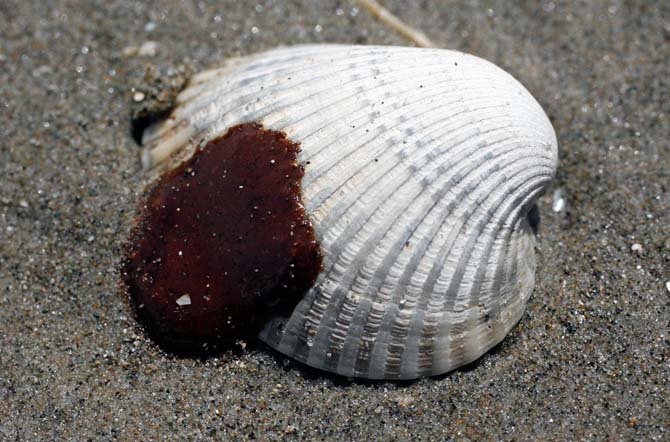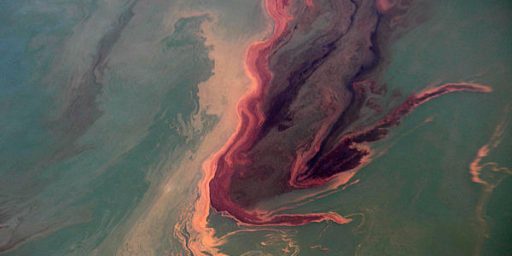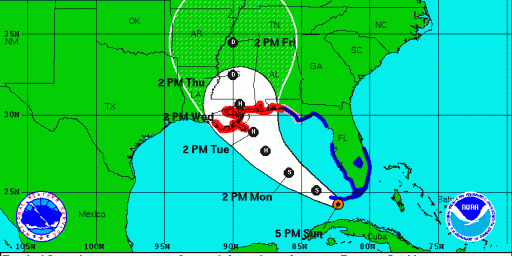Giant Underwater “Oil Plumes” Suggest Gulf Oil Spill Worse Than Feared
 There is further evidence today that the scope of the oil spill in the Gulf of Mexico is worse than previously feared:
There is further evidence today that the scope of the oil spill in the Gulf of Mexico is worse than previously feared:
Scientists are finding enormous oil plumes in the deep waters of the Gulf of Mexico, including one as large as 10 miles long, 3 miles wide and 300 feet thick in spots. The discovery is fresh evidence that the leak from the broken undersea well could be substantially worse than estimates that the government and BP have given.
“There’s a shocking amount of oil in the deep water, relative to what you see in the surface water,” said Samantha Joye, a researcher at the University of Georgia who is involved in one of the first scientific missions to gather details about what is happening in the gulf. “There’s a tremendous amount of oil in multiple layers, three or four or five layers deep in the water column.”
The plumes are depleting the oxygen dissolved in the gulf, worrying scientists, who fear that the oxygen level could eventually fall so low as to kill off much of the sea life near the plumes.
Dr. Joye said the oxygen had already dropped 30 percent near some of the plumes in the month that the broken oil well had been flowing. “If you keep those kinds of rates up, you could draw the oxygen down to very low levels that are dangerous to animals in a couple of months,” she said Saturday. “That is alarming.”
The plumes were discovered by scientists from several universities working aboard the research vessel Pelican, which sailed from Cocodrie, La., on May 3 and has gathered extensive samples and information about the disaster in the gulf.
Scientists studying video of the gushing oil well have tentatively calculated that it could be flowing at a rate of 25,000 to 80,000 barrels of oil a day. The latter figure would be 3.4 million gallons a day. But the government, working from satellite images of the ocean surface, has calculated a flow rate of only 5,000 barrels a day.
BP has resisted entreaties from scientists that they be allowed to use sophisticated instruments at the ocean floor that would give a far more accurate picture of how much oil is really gushing from the well.
“The answer is no to that,” a BP spokesman, Tom Mueller, said on Saturday. “We’re not going to take any extra efforts now to calculate flow there at this point. It’s not relevant to the response effort, and it might even detract from the response effort.”
The undersea plumes may go a long way toward explaining the discrepancy between the flow estimates, suggesting that much of the oil emerging from the well could be lingering far below the sea surface.
What the long-term impact of that oil on the floor of the Gulf might is anyone’s guess, but I can’t imagine that it’s good.






Yeah, thanks a lot for the Algore alarmism.
Listen, the ocean is HUGE–a little oil squirting through the surface isn’t going to hurt anyone–except the guilt of Gore-style libbies who want everyone to drive go-karts instead of cars.
Sub-aquatic volcanoes are happening all the time and nobody cares.
Obama, Gore, and his radical tree=hugger, hippie friends started this leak to push through the cap and tax bill and further pave the way to environmental socialism.
The ocean is fine. The fish will be fine. Stop the propaganda.
What they don’t tell us is the density/concentration of the oil in these plumes. This may actually be a good sign, as the whole point of pumping dispersants under water to the leak site was to allow the oil to “disperse” into the water, diluting it to the point where it is far less damaging than a thin later of concentrated oil slick on the surface.
With hyperbole from the media like “the worst disaster in history”…. How could it now be “worse than previously feared”?[lol]
Does anyone remember the number of oil tankers sunk in the gulf during WWII?…
“During 1942 and 1943, more than 20 U-boats operated in the Gulf of Mexico. They attacked tankers transporting oil from ports in Texas and Louisiana, successfully sinking 56 vessels.”
That’s the stupidest thing I’ve read all day. I’m no engineer, but it seems to me that the rate of flow might be relevant to stopping said flow.
Depends on what they’re doing to stop it. For the “dome” and “top hat” ideas, it would certainly seem relevant. For the “thread the pipe” and “relief well” ideas, not so much.
Alex Alex Alex surely by now you know how corporations work.. BP doesn’t want to know so that when they end up in courts later they won’t have that as evidence against them..
OK Floyd, “second only to the Nazis”
johnpersonna;
Töricht kindisch unlogische Folgerung so sind sicherlich unter der Würde eines solchen überlegenen Intellekt als deine, nicht wahr?
Gee Floyd, I hate to compare apples and apples, but just exactly how big were these “56 vessels”, were they all tankers, and just exactly how much oil did they dump in the Gulf?
Dollars to donuts 25 of these “vessels” equalled ONE “Exxon Valdez”… if even that. (remember, technology has advanced quite a bit in the last 70 years)
If you got no numbers to answer these questions, stfu, cause you got no argument.
By the by, does “dollars to donuts” even make sense anymore? Or am I showing my age?
“Dollars to donuts” has never really made sense to me.
The most common and pretty much the largest tanker used during ww2 was the T2.
Specifications are listed here.
http://en.wikipedia.org/wiki/T2_tanker
Keep in mind back then there were several things limiting tanker size including the Suez canal.
tom p;
I think the number which were actual tankers was reported as 43.
The argument is unrelated to the one you inferred…
The focus should be on capping the leak and moving forward with the clean-up,which could actually be accomplished better with accurate reporting…
But then,the attention of small minds is most easily drawn with hyperbole.
I suspect that every unfortunate incident will continue to be reported as “the worst disaster in history” for the foreseeable future, or at least as long as those who are mesmerized by the tactic continue to ask those who are not to “stfu” while they try to concentrate.
I was bored yesterday and did actually look up the T2, find its capacity in barrels, etc. If you take a midpoint estimate of BP’s oil leak and assume that every tanker sank in WWII was of the latest sort, floyd’s claim is possible.
But geez, going on about small “small minds” who might be confused by “the worst” when it’s possible that a war did more damage 70 years ago?
LOL floyd, that looks like a pretty transparent attempt to divert from the actual damage being done by this spill in the here and now.
Here are some tankers sunk by U-boats during early May 1942 in the Gulf of Mexico followed by the number of barrels of oil products carried as cargo: Virginia 150,000, Pan Massachusetts
55,000, Halo 44,000, Joseph M. Cudahy 77,000, Munger T. Ball 32,000, Aurora 83,000, David McKelvy 81,000, Gulfpenn 56,000. The average of these is 72,500 barrels. If we take 72,500 bbls times 43 tankers sunk in the Gulf during the War, we get 3,096,000 bbls. This does not include leakage from tankers damaged but not sunk and leakage of the oil used as engine fuel for all the ships damaged or sunk.
If we multiply the PB estimate of the current leakage rate for the Deepwater Horizon = 5,000 bbls times 32 days we get 160,000 bbls, which means the oil tankers sunk in the Gulf during the War spilled at least 19 times more petroleum products.
In 1979 the Mexican oil rig Ixtoc-1 exploded and leaked 3.3 million bbls of oil into the Gulf of Mexico, 21 times the Deepwater Horizon’s leakage to date.
The state-controlled liberal propaganda media is hyping the Deepwater Horizon spill to the max in hopes they can stir up the ignorant masses to stop all US offshore drilling. This will be great for the Chinese and Russians who are scouring the world for places they can drill.